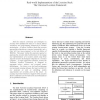Free Online Productivity Tools
i2Speak
i2Symbol
i2OCR
iTex2Img
iWeb2Print
iWeb2Shot
i2Type
iPdf2Split
iPdf2Merge
i2Bopomofo
i2Arabic
i2Style
i2Image
i2PDF
iLatex2Rtf
Sci2ools
WMCSA
2003
IEEE
2003
IEEE
Real-world Implementation of the Location Stack: The Universal Location Framework
Both the research community and developers in industry have identified the need for a clearly defined vocabulary and programming framework for location technologies. A layered Location Stack that provides ate abstractions, common terminology, and a clear API has been proposed in the last edition of WMCSA. This paper relates the experience gained in the Location Stack abstractions to the design and implementation of a location system using three separate location technologies integrated in a wireless computer. A single application interface, termed the Universal Location Framework, is designed to aggregate indoor, outdoor, and proximity sensor technologies. Our focus is on how well partitioning and parameter passing between the layers worked for our purposes as well as identifying system requirements not currently part of the stack. In closing, we provide evidence in support of the Location Stack’s usefulness and we make some recommendations for its potential evolution.
| Added | 05 Jul 2010 |
| Updated | 05 Jul 2010 |
| Type | Conference |
| Year | 2003 |
| Where | WMCSA |
| Authors | David Graumann, Jeffrey Hightower, Walter Lara, Gaetano Borriello |
Comments (0)

